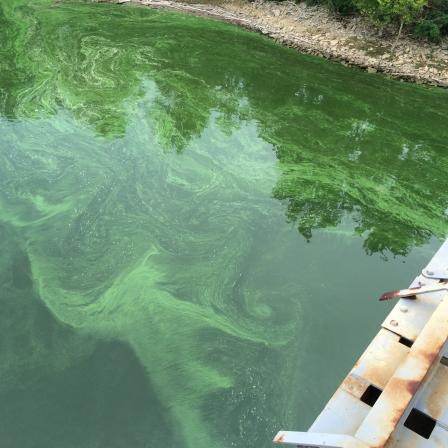Keeping the Water Flowing: Helping Water Treatment Facilities Handle Harmful Algal Blooms
Published on June 4, 2018
When you encounter health advisory signs due to a harmful algal bloom (HAB) in your favorite isolated swimming hole or fishing spot, it’s important that you keep yourself and your pets out of the water until conditions improve. But when toxin-laden cyanobacteria—the cause of HABs—levels spike in areas that serve as drinking water sources, just waiting it out can leave thousands without a basic necessity: clean, healthy water.
EPA engineer Nicholas Dugan and his collaborators are helping water treatment facilities keep the water flowing even in the face of harmful algal blooms.
 A bloom on the Ohio River. He and his research partners are conducting lab tests to explore what techniques and protocols offer the best solutions for treating source water that is contaminated with cyanobacteria and the toxins they contain and release. They share what they learn with water treatment utilities and professional organizations so they are more prepared to handle the next bloom.
A bloom on the Ohio River. He and his research partners are conducting lab tests to explore what techniques and protocols offer the best solutions for treating source water that is contaminated with cyanobacteria and the toxins they contain and release. They share what they learn with water treatment utilities and professional organizations so they are more prepared to handle the next bloom.
In their latest study, Dugan and his partners conducted a series of bench-scale trials to simulate the real world conditions that water utilities are likely to face when their source water becomes contaminated with cyanobacteria. First, the team prepared mixtures of water and cyanobacteria in beakers. While the concentrations of cyanobacteria were kept relatively consistent, they varied pH and turbidity levels to mimic the different conditions that water treatment facilities are likely to experience. The samples were then subjected to water treatment scenarios using different levels of potasium permanganate (KMnO4), a standard water treatment oxidant. Further tests included treatments with powdered activated carbon (PAC) after a set time period of oxidant exposure.
Analyses included pre- and post-treatment measurements of the following:
- total (intact) cyanobacterial cells,
- cyanobacterial cells with compromised cell membranes,
- toxins found outside cells,
- toxin levels from both outside and within cells,
- chlorophyll-a, and
- KMnO4 residual concentrations.
Chlorophyll-a and the fractions of membrane-compromised cells can serve as indicators of changes in the cyanobacterial cells. Changes in these indicators, especially in conjunction with toxin releases, can serve as evidence that some treatment protocols can harm cyanobacterial cells and promote the release of toxins into solution, increasing the potential for health risks.
The research showed that “the greatest toxin releases were observed at the lowest KMnO4 [potasium permanganate] doses,” and that the application of powdered activated carbon “resulted in extracellular toxin concentrations that were markedly lower than those observed in oxidant-only situations” (Dugan, et al., 2018, currently in press).
What does that mean for water treatment facilities? For one, while it confirms that HABs present a significant potential threat to drinking water, major new investments may not be needed. Instead, many water treatment facilities can reduce the probability of toxin passage with vigilance and the proper dosing of potasium permanganate and powdered activated carbon.
“The goal of our research is to help water treatment facilities optimize their existing infrastructure in order to safely handle harmful cyanobacterial blooms for their customers. This latest work explains how cyanobacterial cells react in the presence of a common oxidant and provides information that can be used to tweak standard practices to keep the water safely flowing from the treatment plant to the tap,” explains Dugan.
He and his colleagues are working closely with EPA’s Office of Water, state and local officials, and professional organizations to share what they learn and help drinking water facilities be better prepared for the next harmful algal bloom.
Learn More
Video: EPA scientist Nicholas Dugan works to Safeguard our Drinking Water
